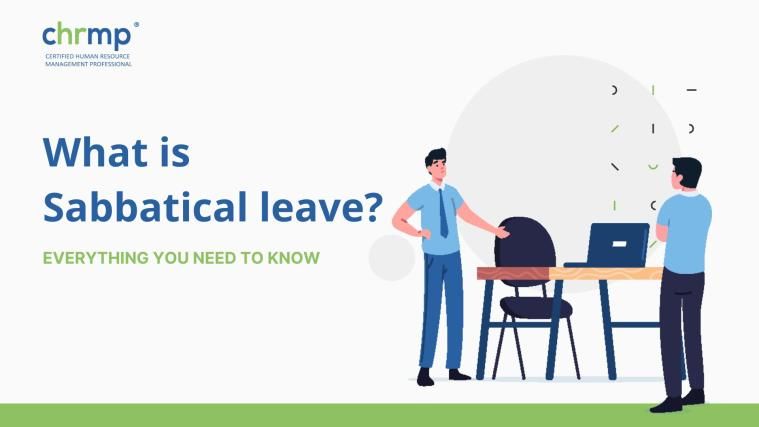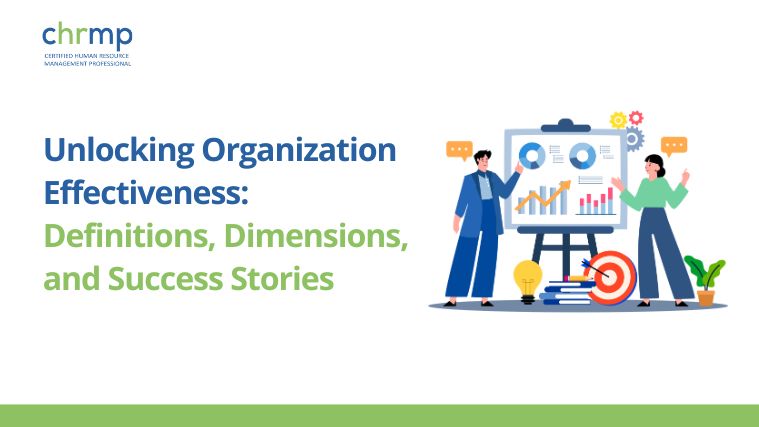When work seems overwhelming, combined with other things that seem too pressing for want of effort and time. Well then, it’s time for a sabbatical leave! It can range from a month to a year when one can pursue one’s passion or other developmental opportunities. In this What is Sabbatical Leave blog, we’re going to discuss everything about sabbaticals. We’ll discuss the benefits of sabbatical leave, the request process, and more.
It is like a mini-retirement with the benefit of a comeback opportunity to the same profession or organisation.
Feeling burned-out? Or want to take an extended break to focus on your passion? Whatever the reason, after decades of the monotonous journey to the office and back, a long break is well deserved.
So we have got you covered whether you’re an employee considering a sabbatical or an employer looking to implement a sabbatical program.
So let’s get started without further ado!
What is a Sabbatical?
A sabbatical is a period away from work, typically ranging from a few months to a year, during which an employee can pursue personal or professional development opportunities.
A sabbatical gives us some time in life to ponder upon maybe the direction we are moving in or if our current achievements match the expectations that we have of ourselves, the areas that need improvement to make us more wholesome, better and accomplished human beings or whether we need to change our profession and the level of contentment in life.
It gives us a fresh perspective on every colour of the kaleidoscope we call life. We get back with renewed vigour, energy and attitude to work or profession sometimes armed with new and better skills to tackle life and its myriad problems or difficulties.
A sabbatical is a kind of leave usually granted to tenured professors, researchers and other highly skilled professionals who have shown unwavering commitment to their work and have made significant contributions to their organisation.
What is Sabbatical Leave from Work? A Definition
A sabbatical is a period away from work, typically ranging from a few months to a year, during which an employee can pursue personal or professional development opportunities.
A sabbatical gives us some time in life to ponder upon maybe the direction we are moving in or if our current achievements match the expectations that we have of ourselves, the areas that need improvement to make us more wholesome, better and accomplished human beings or whether we need to change our profession and the level of contentment in life.
It gives us a fresh perspective on every colour of the kaleidoscope we call life. We get back with renewed vigour, energy and attitude to work or profession sometimes armed with new and better skills to tackle life and its myriad problems or exigencies.
A sabbatical is a kind of leave usually granted to tenured professors, researchers and other highly skilled professionals who have shown unwavering commitment to their work and have made significant contributions to their organisation.
Why is a Sabbatical Important? 7 Benefits of a Sabbatical Leave
Sabbatical leave is a significant employee benefit that allows individuals to take a break from work and pursue personal or professional development opportunities.
It allows employees to recharge, gain new skills, and return to work with renewed energy and perspective.
Taking a sabbatical leave can have many benefits for an employee’s well-being.
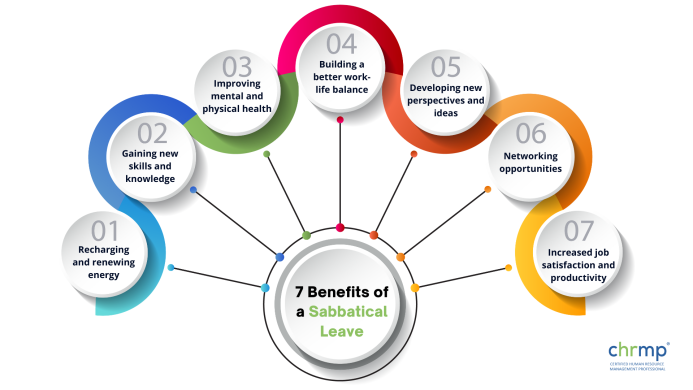
Let’s take a look at each of them:
1. Recharging and renewing energy
A sabbatical allows employees to take a break from their daily routine and recharge their batteries, which can help them return to work with renewed energy and motivation.
2. Gaining new skills and knowledge
During a sabbatical, employees can take classes, attend workshops, or pursue other educational opportunities that can help them develop new skills and knowledge that they can bring back to their job.
3. Improving mental and physical health
A sabbatical can allow employees to take care of their mental and physical health, which can improve their overall well-being and productivity at work.
4. Building a better work-life balance
A sabbatical can help employees find a better balance between their work and personal lives, which can lead to greater job satisfaction and a more positive attitude towards work.
5. Developing new perspectives and ideas
A sabbatical can expose employees to new cultures, ideas, and ways of thinking that can inspire new perspectives and ideas that they can bring back to their job.
6. Networking opportunities
A sabbatical can provide employees with opportunities to meet new people and expand their professional networks, which can be beneficial for their career development.
7. Increased job satisfaction and productivity
A sabbatical can improve an employee’s overall job satisfaction, motivation, and productivity when they return to work, which can be beneficial for both the employee and the employer.
But What’s There In It For The Employer? Benefits of Sabbatical Leave for the Organisation
How will letting a highly skilled senior employee take a months-long break benefit the employer?
Well, the employer benefits from a more motivated, recharged enthused and engaged employee. Thus, overall a sabbatical leave can lead to a more productive, professionally satisfied and engaged workforce.
Apart from getting a more enthused, focused, more productive and engaged employee, which, if charted in arithmetic progression, leads to an entirely brilliant workforce, which is probably every organisation’s dream.
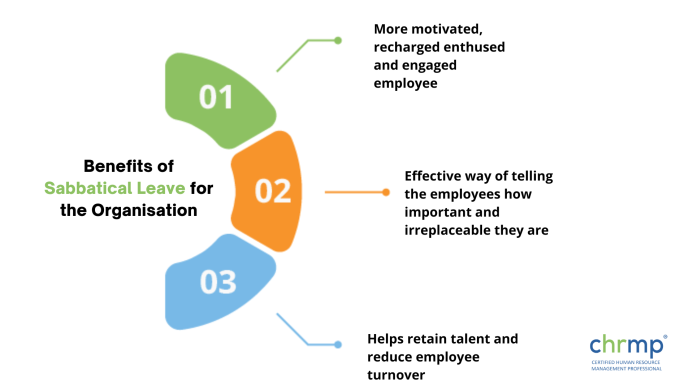
It is also a very effective way of telling the employees how important and irreplaceable they are to the organisation. It boosts an employee’s faith in the organisation tremendously.
Also, the organisation values their contribution, and employees feel more motivated to give their 100% to the organisation. This also increases their job satisfaction. It’s a complete win-win situation both for the employer and employees. It also shows that the employer or the organisation is interested in the personal growth and development of its employees. Strategically it is also an excellent tactic to retain talent and reduce employee turnover.
How Does A Sabbatical Leave Work?
The specifics of how a sabbatical leave works can vary depending on the employer and the employee’s job. Generally speaking, the process of taking a sabbatical can be listed below:
1. Requesting a sabbatical
The employee requests a sabbatical leave from their employer, outlining the proposed length of the leave, the activities they plan to pursue during the leave, and how they plan to transition their work responsibilities to others.
2. Approval
The employer reviews the request and decides whether to approve or deny the leave. They may also suggest modifications to the employee’s proposal before granting approval.
3. Planning
Once the sabbatical is approved, the employee and employer work together to plan the details of the leave, including how the employee’s work will be covered during their absence and how the employee will transition back to their job upon their return.
4. Taking the sabbatical
The employee takes the sabbatical leave as planned, pursuing the activities they had outlined in their proposal.
5. Returning to work
The employee returns to work after the sabbatical leave and often shares with their colleagues and employer the new knowledge and skills acquired during the leave and how they plan to apply it to their work.
It’s worth noting that not all companies offer sabbatical leaves, and for those that do, the rules and regulations for sabbatical leaves can vary. Some organisations may have specific policies and procedures for requesting and taking a sabbatical, while others may have more flexible arrangements. It’s essential to check with your employer to understand the specifics of their sabbatical leave program.
What’s the Difference Between A Sabbatical Leave and A Vacation?
A sabbatical and vacation are both types of time off from work, but they have some key differences.
The primary purpose of a vacation is to provide employees with time to relax, recharge, and spend time with family and friends, while a sabbatical is meant to give the employees time to pursue personal or professional development opportunities, such as education, research, travel, or volunteer work.
Vacations are typically shorter in duration, usually a week or two, whereas sabbaticals can last for several months to a year. Also, vacations are generally available to all employees, regardless of their tenure or job level.
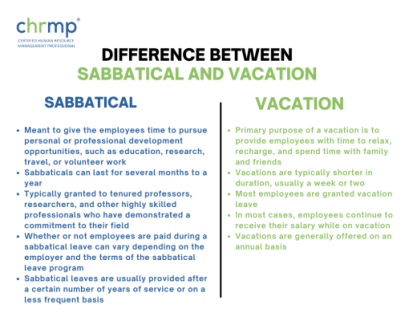
Sabbaticals are typically granted to tenured professors, researchers, and other highly skilled professionals who have demonstrated a commitment to their field and have made significant contributions to their organisation.
In most cases, employees continue to receive their salary while on vacation. However, whether or not employees are paid during a sabbatical leave can vary depending on the employer and the terms of the sabbatical leave program.
Vacations are a regular part of an employee’s benefits package, and employees are expected to return to work after a vacation. After a sabbatical leave, employees are also likely to return to work, but they often bring back new knowledge, skills, and perspectives that can benefit the company.
Vacations are generally offered on an annual basis, while sabbatical leaves are usually provided after a certain number of years of service or on a less frequent basis.
Are employees paid during a sabbatical leave?
Whether or not employees are paid during a sabbatical leave can vary depending on the employer and the terms of the sabbatical leave program. Some employers may pay employees their full salary while they are on sabbatical leave, while others may pay a reduced wage or no compensation at all. Some employers may also require employees to use their vacation or sick time during the sabbatical leave.
In some cases, employees may be able to use other types of paid leave, such as the Family and Medical Leave Act (FMLA) or short-term disability leave, in conjunction with a sabbatical leave. In other cases, employees may be able to work out alternative arrangements with their employer, such as part-time work or consulting work while on sabbatical leave.
It’s also worth noting that some employees may choose to use their sabbatical leave to pursue volunteer work or other unpaid opportunities, in which case they would not be paid during the leave. It’s essential to check with your employer to understand the specifics of their sabbatical leave program and the payment arrangements for the leave.
Developing A Sabbatical Leave Policy
Developing a sabbatical leave policy involves several steps:
1. Define the purpose and goals of the sabbatical leave program
Clearly define the purpose and goals of the sabbatical leave program, such as providing employees with the opportunity to recharge, gain new skills, and return to work with renewed energy and perspective.
2. Determine eligibility
Decide who is eligible for a sabbatical leave, such as tenured professors, researchers, and other highly skilled professionals who have demonstrated a commitment to their field and have made significant contributions to the organisation.
3. Establish the length of the sabbatical:
Determine the length of the sabbatical leave, such as several months to a year.
4. Determine the pay and benefits:
Decide whether or not employees will be paid during the sabbatical leave, and if so, at what rate. Also, establish the benefits employees will be eligible to receive while on sabbatical.
5. Develop a process for requesting and approving sabbatical leave
Establish a clear process for employees to request and be approved for a sabbatical leave, including any required documentation and timelines.
6. Develop a plan for covering the employee’s work during the sabbatical
Develop a plan for how the employee’s work will be covered during their absence, such as reassigning their responsibilities to other employees or hiring temporary staff.
7. Develop a plan for the employee’s return
Develop a plan for how the employee will transition back to their job upon their return, including any training or support they may need.
8. Communicate the policy
Clearly communicate the sabbatical leave policy to all employees and ensure that they understand the process for requesting and taking a sabbatical leave.
9. Review and update the policy regularly
Review the sabbatical leave policy regularly and update it as necessary to ensure it is meeting the needs of the organisation and its employees.
It is essential to make sure that the sabbatical policy is in compliance with the laws of the country and state where the company operates. Additionally, it is a good practice to consult with legal and HR experts when developing the policy.
How Long is an Ideal Sabbatical Leave?
A sabbatical leave should be longer than a standard vacation, hence, the minimum duration should be at least four weeks.
This will help employees to shift their focus away from work to enjoy the optimum benefits of the leave.
The maximum duration can range from three months to 6 months.
Ultimately, setting the duration for a sabbatical leave should depend on the maximum time that your company can function efficiently while an experienced employee is absent.
Examples of companies that offer sabbatical leave
There are many companies that offer sabbatical leave as a benefit to their employees. Some popular examples include Google, Netflix and LinkedIn.
These companies offer sabbaticals to their employees. Google offers up to six months of sabbatical with full pay. It also has a re-entry program to ease the transition of the employees back to work again after the sabbatical smoothly.
Netflix prefers to call it ‘leave of absence’. Employees can avail sabbatical for up to one year with full pay and benefits.
LinkedIn also offers its employees a sabbatical of six months with full pay, which can be availed at any time of their tenure.
It’s worth noting that the policies for sabbatical leave can vary among different departments and locations within the same company, and it’s always best to check with your HR department or supervisor for the specific details of your company’s sabbatical leave policy.
What is Sabbatical Leave FAQs
1. Do you get paid during sabbatical leave?
A: It depends on the company’s policy. Some companies offer full pay and benefits during sabbatical leave, while others may provide a reduced salary or no pay at all.
2. How Long Is a Sabbatical Leave?
A: The length of a sabbatical varies from company to company, some companies offer a few weeks to a few months, while others offer up to a year.
3. Who Can Take a Sabbatical?
A: The eligibility for sabbatical leave varies from company to company. Some companies offer it to all employees, others only to employees who have reached a certain number of years of service or have a specific job title.
4. Should You Offer Sabbatical Leave?
A: It depends on the company’s resources and goals. Offering a sabbatical leave can be a great way to retain and motivate employees, but it can also be costly and disruptive to the company’s operations. It’s essential to weigh the pros and cons before making a decision.
5. Is a sabbatical a good idea?
A: A sabbatical can be an excellent way for employees to recharge, gain new experiences, and return to work with renewed energy and new skills. It’s a good idea for both the employee and the company as long as it’s well-planned and executed.
6. What do you do on sabbatical leave?
A: The purpose of sabbatical leave varies from person to person. It can be used for personal development, travel, volunteer work, pursuing a passion project, or taking care of personal matters.
7. Can you work during your sabbatical leave?
A: It depends on the company’s policy. Some companies prohibit any kind of work during sabbatical leave, while others may allow employees to work on projects or activities related to their personal or professional interests. It’s best to check with your employer for the specific details of your company’s sabbatical leave policy.

